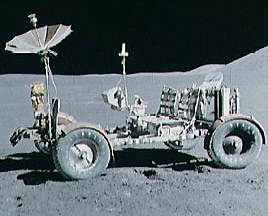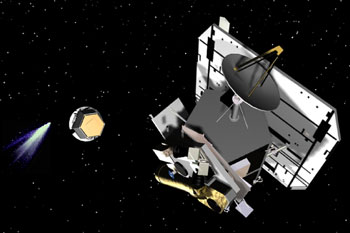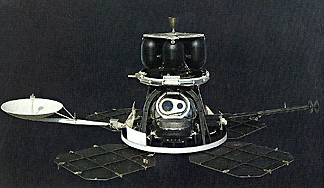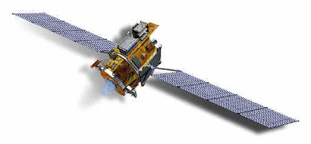An artist's conception of Deep Space 1
Click on image for full size
Image courtesy of NASA
NASA Tests New Technologies with Deep Space 1
We are far too quick to report disasters when it comes to space exploration...but here's a definite success!
NASA launched a spacecraft called Deep Space 1 on October 15, 1998. Deep Space 1 tested
twelve new technologies, including a different type of engine
and a smart navigation system. The spacecraft tested the equipment
while it flew to a nearby asteroid, called Braille.
The engines on Deep Space 1 used xenon gas as a propellant. Solar panels collected the Sun's
energy and used it to give the xenon gas an electric charge. The gas was
then accelerated through an electric field to speeds around 65,000 mph (miles per hour).
The thrust that was produced was less than the weight of a piece of paper
but it still accelerated the spacecraft about 20 mph each day. Its
speed continued to build up because there isn't any air resistance in
the vacuum of space. Ion-propulsion engines are ten times more
efficient than regular rocket
engines.
Deep Space 1 also had an onboard navigation system. It kept
track of a number of stars and could calculate its own position.
Normally, spacecraft have to rely on people at NASA to tell them where they
are.
Things went so well in the first two years of the mission, that NASA decided to send Deep Space 1 to visit comet Borrelly in September 2001. It took really great pictures of this comet!
The Deep Space mission ended on December 18, 2001.
You might also be interested in:

The Hubble Space Telescope (HST) was one of the most important exploration tools of the past two decades, and will continue to serve as a great resource well into the new millennium. The HST found numerous
...more
Driven by a recent surge in space research, the Apollo program hoped to add to the accomplishments of the Lunar Orbiter and Surveyor missions of the late 1960's. Apollo 11 was the name of the first mission
...more
Apollo 12 was launched on Nov. 14, 1969, surviving a lightning strike which temporarily shut down many systems, and arrived at the Moon three days later. Astronauts Charles Conrad and Alan Bean descended
...more
Apollo 15 marked the start of a new series of missions from the Apollo space program, each capable of exploring more lunar terrain than ever before. Launched on July 26, 1971, Apollo 15 reached the Moon
...more
NASA chose Deep Impact to be part of a special series called the Discovery Program on July 7, 1999. The Discovery program specializes in low-cost, scientific projects. In May 2001, Deep Impact was given
...more
The Galileo spacecraft was launched on October 19, 1989. Galileo had two parts: an orbiter and a descent probe that parachuted into Jupiter's atmosphere. Galileo's main mission was to explore Jupiter and
...more
During 1966 through 1967, five Lunar Orbiter spacecrafts were launched, with the purpose of mapping the Moon's surface in preparation for the Apollo and Surveyor landings. All five missions were successful.
...more















